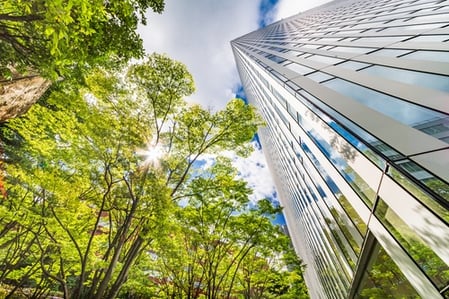What Are Zero Energy Buildings?

Zero energy buildings (ZEB) are efficient constructions that produce enough renewable energy on site to meet their annual consumption and associated losses. ZEBs reduce the consumption of non-renewable energy in the building sector.
Buildings have many energy needs, which include space heating, cooling, ventilation, hot water, lighting, plug loads, process energy and transportation. The first step to achieve ZEBs is increasing energy efficiency, and there are several viable methods:
-
Green building construction using passive design
-
Efficient building systems and appliances
-
Enhancing energy efficiency with maintenance and changes in user behavior.
Once a building has become as efficient as possible, the second step is addressing the remaining energy needs with on-site renewable generation, and surplus generation is transferred to the grid. Some examples are wind, solar and hydro energy.
Improve the energy performance of your building.
How to Achieve Zero Energy Buildings
Zero energy is an achievable goal, and more developers are becoming interested in zero energy buildings. To facilitate the understanding of a ZEB, the US Department of Energy (DOE) and the National Institute of Building Sciences developed a common definition that can be applied to individual buildings, campuses, portfolios and communities.
The report “A Common Definition for Zero Energy Buildings” was created to establish key definitions, nomenclature and measurement guidelines for governments, institutions and building owners. To be considered a ZEB, a building must meet two important conditions:
-
The building must be energy efficient.
-
The energy produced on site is greater than or equal to the energy consumed at the source.
-
In other words, site energy production must be high enough to meet building needs, while having enough surplus production to match or exceed source energy usage.
To better understand the definition of a ZEB, the first step is defining the site boundary: the line that marks the building limits, across which delivered energy and exported energy are measured.
-
Delivered energy is any type of energy that can be bought for use in the building. This includes grid electricity, district heating and cooling, and fuels (renewable and non-renewable).
-
Exported energy is on-site renewable generation that is used outside the site boundary. This usually occurs through the electricity grid, but renewable energy can also be used to charge electric cars used outside.
Basically, a ZEB balances its energy consumption so that exported energy is equal or greater than delivered energy on an annual basis. The building can be a net consumer of electricity during some months, as long as it reaches net production or zero net consumption annually.

The Importance of Source Energy
The US Environmental Protection Agency emphasizes the importance of source energy when analyzing the performance of a building, since it reflects the true impact of the property.
Consider that the energy reaching a building does not get there by itself - a lot of energy is also used for production and delivery. For example:
-
Electricity delivery causes power network losses
-
Natural gas delivery requires compressor stations
-
Many fuels are delivered by truck.
You can have a building that produces enough energy to match site consumption, but it is not really a ZEB. Even though production and consumption are equivalent locally, source energy consumption is higher; the building is a net consumer, even when it seems like a ZEB based on local consumption and generation.
How Renewable Energy Certificates Incentive ZEBs
Renewable Energy Certificates (REC) are an effective incentive for clean energy generation. Authorities establish renewable energy targets that are mandatory for key players in the power sector, such as utility companies and major consumers. These organizations must deliver a specified number of RECs at regular intervals, or they face hefty penalties. In turn, RECs are credited based on renewable energy generation.
-
When a REC program is introduced, energy consumers that are not subject to renewable energy targets can also earn them. Although the exact rate may change, the most common practice is awarding one REC for every 1,000 kWh of generation.
-
Companies subject to clean energy targets normally use their own RECs, but they can also purchase them from others.
-
Buildings with renewable energy systems now get two financial benefits: the savings from producing their own power, and the income from REC sales.
REC programs provide an incentive for building owners to produce more renewable energy. Therefore, more properties can become ZEBs. Moving toward zero energy buildings provides many long-term advantages: lower environmental impacts, reduced operation and maintenance costs, greater resilience against blackouts and natural disasters, and improved energy security.

Anuj Srivastava
Anuj Srivastava is a principal partner at NY Engineers. He is known for his MEP franchise market knowledge. Anuj is currently leading a team of 100+ MEP/FP engineers and has successfully led over 1500 franchise projects in the US.
Join 15,000+ Fellow Architects and Contractors
Get expert engineering tips straight to your inbox. Subscribe to the NY Engineers Blog below.



